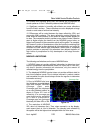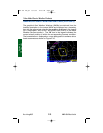
2-14
KMD 250 Pilot's Guide
Section 2
FIS Operation
Value Added Service Weather Products
Rev 4 Aug/2007
NEXRAD ABNORMALITIES
The following is a list of NEXRAD abnormalities that may be experi-
enced:
1. Each NEXRAD site can operate in two modes, "Clear Air" mode or
"Precipitation" mode. When no significant precipitation exists in the scan-
ning area of the radar a NEXRAD site produces images in the "Clear Air"
mode. In this mode the radar is very sensitive to small targets, making it
possible to detect minute particles such as pollen, smoke and dust.
2. Ground clutter is detected when nearby buildings, trees, and towers
reflect radar energy back to the NEXRAD site. Because NEXRAD is a
Doppler radar, many stationary targets are filtered out. However, if a
tower or tree sways slightly in the wind, it will show up on the scan as a
target. These “moving” objects are the targets referred to as ground
clutter. Radar returns from very near the site (within a radius 20-30 nau-
tical miles) indicating very high reflectivities often include ground clutter.
3. Strobes are spurious radar data caused primarily by defractive
bending of the beam back down to the ground. This often happens in
areas where cool air interacts with prevailing warm air, such as along
coastlines and over oceans or other large bodies of water. Blocky and
linear features are characteristics of strobes within the displayed data.
4. Sun strobes occur when a radar antenna points directly at the sun.
This shows up as high reflectivity for one or two radials. Sun strobes are
shown as bright colored spikes on the display.
5. Military planes deploy metallic dust known as 'chaff' to diffuse their
radar signatures and mask their presence on radar. Pilots frequently
practice laying chaff trails over open ocean, although these trails often
drift over land causing alterations in weather radar scans.
6. When a solid object, such as a mountain, intersects a radar beam, it
blocks any reflectivity beyond that point and produces a shadow within
the display.
7. When a building near a NEXRAD site is taller than the tower on
which the radar antenna resides, it can block the beam, casting a long,
narrow shadow (blank space) in the display.
8. NEXRAD sites sometimes return data that is entirely spurious. This
is known as "going critical" and usually does not last longer than a few
hours.
9. Atmospheric temperature inversions cause radar returns from the
Earth's surface resulting in Anomalous Propagation (AP) echoes on the
radar display.
KMD 250 FIS_R4 8/13/07 10:07 AM Page 2-14


















